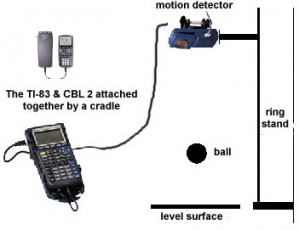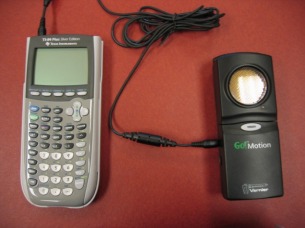Elise Livingston
Motion Lab
Purpose
- Create a positsion vs. time graph
- Gain competence in the use of a motion detector and related equipment
- Understand the relationship between position vs. time, velocity, and acceleration
Equipment
- TI-84 Calculator-Based Lab Unit (CBL-II)
- Motion detector
- Meter stick
- Computer with Loggerpro software
- Create a positsion vs. time graph
- Gain competence in the use of a motion detector and related equipment
- Understand the relationship between position vs. time, velocity, and acceleration
Equipment
- TI-84 Calculator-Based Lab Unit (CBL-II)
- Motion detector
- Meter stick
- Computer with Loggerpro software
Procedure
- Develop a position vs. time story that describes a body in motion incorporating at least the following four types of motion
- standing still
- moving with constant velocity
- moving with variable negative velocity
- moving with variable positive velocity
- Illustrate the story on a position vs. time graph. Use a legend to cross reference sections of the graph with the corresponding sections of the story.
Data / Analysis
Story: Tamara's Adventure
1. Tamara arrives at a park and begins her refreshing morning run and travels 1.5 miles before realizing that she is lost.
2. Then she begins to jog on the opposite direction for 1.2 miles.
3. Then, Tamara becomes tired and must stop and rest for 25 minutes.
4. Tamara soon encounters a dog that proceeds to chase her for .5 miles.
5. To try to lose the dog, Tamara changes direction and runs at varying speeds for another 1.5 miles before the dog loses interest and goes away. Tamara has a long walk home.
Tamara's Adventure: Position vs. Time Graph
- Develop a position vs. time story that describes a body in motion incorporating at least the following four types of motion
- standing still
- moving with constant velocity
- moving with variable negative velocity
- moving with variable positive velocity
- Illustrate the story on a position vs. time graph. Use a legend to cross reference sections of the graph with the corresponding sections of the story.
Data / Analysis
Story: Tamara's Adventure
1. Tamara arrives at a park and begins her refreshing morning run and travels 1.5 miles before realizing that she is lost.
2. Then she begins to jog on the opposite direction for 1.2 miles.
3. Then, Tamara becomes tired and must stop and rest for 25 minutes.
4. Tamara soon encounters a dog that proceeds to chase her for .5 miles.
5. To try to lose the dog, Tamara changes direction and runs at varying speeds for another 1.5 miles before the dog loses interest and goes away. Tamara has a long walk home.
Tamara's Adventure: Position vs. Time Graph
Instructions for movement in front of motion detector:
1. Begin standing several feet from the motion detector.
2. Move a distance toward the motion detector at a relatively constant speed.
3. Move half of the previous direction away from the motion detector.
4. Pause for a moment, remaining as still as possible to signify the time Tamara rests in the story.
5. Move a short distance away from the detector.
6. Move toward the detector at varying speeds.
Note: All movements must be performed in quick succession and within roughly 5 seconds in order to obtain the desired graph.
Conclusion
The purpose of this lab was to acquaint us with the motion detector and related lab equipment as well as to give us more practice with creating position vs. time graphs. I found that this lab fulfilled its purposes. We learned that, when working with motion detectors, movement must be very precise to acquire the desired graph. Also, we become somewhat familiarized with the LoggerPro computer software. We are now more competent than before with the use of this particular lab equipment, and I am much more comfortable with the construction of a position vs. time graph.
1. Begin standing several feet from the motion detector.
2. Move a distance toward the motion detector at a relatively constant speed.
3. Move half of the previous direction away from the motion detector.
4. Pause for a moment, remaining as still as possible to signify the time Tamara rests in the story.
5. Move a short distance away from the detector.
6. Move toward the detector at varying speeds.
Note: All movements must be performed in quick succession and within roughly 5 seconds in order to obtain the desired graph.
Conclusion
The purpose of this lab was to acquaint us with the motion detector and related lab equipment as well as to give us more practice with creating position vs. time graphs. I found that this lab fulfilled its purposes. We learned that, when working with motion detectors, movement must be very precise to acquire the desired graph. Also, we become somewhat familiarized with the LoggerPro computer software. We are now more competent than before with the use of this particular lab equipment, and I am much more comfortable with the construction of a position vs. time graph.



